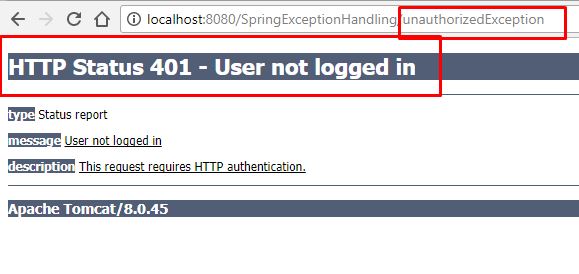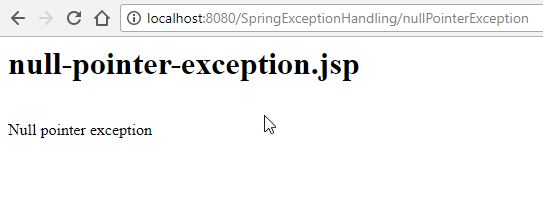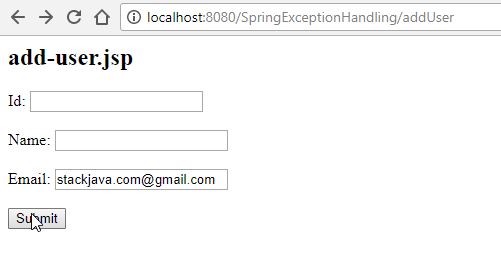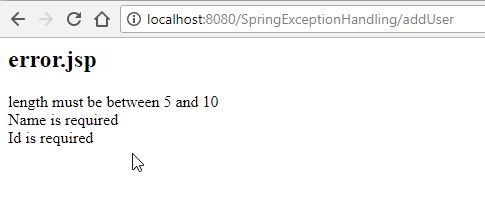Spring MVC – Code ví dụ xử lý Exception, Exception Handling Spring MVC
Trong Spring có khá nhiều cách xử lý exception khác nhau, xử lý exception theo loại exception, theo error code, xử lý chung theo class, theo package hay cho cả project.
Trong bài trước về Spring Form Validation chúng ta xử lý validate object bằng BindingResult ở mỗi method, bạn hoàn toàn có thể gộp chung tất cả các exception validate form vào chung một xử lý.
Dưới đây mình sẽ giới thiệu một số cách xử lý exception khác nhau, các bạn có thể tìm hiểu để áp dụng vào từng trường hợp của mình.
Lưu ý: để xử lý global exception cần khai báo <mvc:annotation-driven /> trong file spring config .xml
1. Xử lý Exception sử dụng HTTP Status Codes
Sử dụng annotation @ResponseStatus trước class định nghĩa exception sẽ chỉ dẫn HTTP Code trả về khi exception này xảy ra.
Ví dụ:
@ResponseStatus(value = HttpStatus.UNAUTHORIZED, reason = "User not logged in") // 401
public class UnauthorizedException extends RuntimeException {
private static final long serialVersionUID = 1L;
}
@RequestMapping(value = "/unauthorizedException")
public String testUnauthorizedException() throws IOException {
throw new UnauthorizedException();
}
url /unauthorizedException ném ra exception UnauthorizedException, exception UnauthorizedException sẽ trả về trang error 401 với message là “User not logged in”.

Khi xảy ra exception UnauthorizedException ứng dụng web sẽ xử lý đúng như trường hợp xảy ra lỗi 401.
Ví dụ mình config error page cho 401 là trang 401.jsp
<error-page> <error-code>401</error-code> <location>/WEB-INF/error-pages/401.jsp</location> </error-page>
<html> <head> <meta http-equiv="Content-Type" content="text/html; charset=UTF-8"> <title>401</title> </head> <body> 401 - User not logged in. </body> </html>
Kết quả:

2. Xử lý exception dựa trên Controller
Sử dụng Annotation @ExceptionHandler
Bạn có thể định nghĩa các method xử lý lỗi bằng cách thêm annotation @ExceptionHandler trước method đó để chỉ dẫn rằng method đó sẽ xử lý cho exception nào.
Các Exception được ném ra thừ các method được đánh dấu @RequestMapping sẽ được các method đó xử lý.
Với cách này bạn có thể trả về view tùy ý khi exception xảy ra.
Ví dụ:
@ExceptionHandler(NullPointerException.class)
public String processNullPointerException() {
return "null-pointer-exception";
}
@RequestMapping(value = "/nullPointerException")
public String testNullPointerException() throws NullPointerException {
throw new NullPointerException("this is null pointer exception");
}
Method processNullPointerException sẽ xử lý tất cả các exception NullPointerException ném ra từ các @RequestMapping trong cùng class.
Url “/nullPointerException” ném ra NullPointerException nên sẽ được xử lý bởi method processNullPointerException
<html> <head> <meta http-equiv="Content-Type" content="text/html; charset=UTF-8"> <title>NullPointerException</title> </head> <body> <h1>null-pointer-exception.jsp</h1><br/> Null pointer exception </body> </html>
Kết quả:

Sử dụng Annotation @ControllerAdvice
Khi sử dụng annotation @ControllerAdvice cho class, thì các method được đánh dấu @ExceptionHandler có thể xử lý exception cho cả các method của các class khác, package khác.
// Xử lý Exception cho tất cả các class
@ControllerAdvice
public class GlobalExceptionHandling {
//...
}
// Xử lý các exception cho các class trong package:
@ControllerAdvice(basePackages="stackjava.com.springexceptionhanding.controller")
public class GlobalExceptionHandling {
//...
}
Ví dụ:
@ControllerAdvice
public class GlobalExceptionHandling {
@ExceptionHandler(IOException.class)
private ModelAndView processIOException(IOException ex) {
ModelAndView model = new ModelAndView("error");
model.addObject("error", ex.getMessage());
return model;
}
}
@RequestMapping(value = "/ioException")
public String testIOException() throws IOException {
throw new IOException("this is io exception");
}
<html>
<head>
<title>Error</title>
</head>
<body>
<h2>error.jsp</h2>
${error}
</body>
</html>
Kết quả:

Ví dụ sử lý exception khi validate form:
public class User {
@NotNull(message = "Id is required")
private Integer id;
@NotBlank(message = "Name is required")
@Length(min = 5, max = 10)
private String name;
@NotBlank(message = "Email is required")
@Email
private String email;
//getter/setter
}
@ExceptionHandler(org.springframework.validation.BindException.class)
private ModelAndView processInvalidData(BindException ex) {
StringBuilder error = new StringBuilder();
for (ObjectError objectError: ex.getAllErrors()) {
error.append(objectError.getDefaultMessage());
error.append("<br/>");
}
ModelAndView model = new ModelAndView("error");
model.addObject("error", error);
return model;
}
@RequestMapping(value = "/addUser", method = RequestMethod.POST)
public String doPostAddUser(@ModelAttribute("user") @Validated User user) {
return "view-user";
}
*Lưu ý: trong method doPostAddUser sẽ không có tham số BindingResult sau tham số được đánh dấu @Validate/@Valid
Kết quả:


Code ví dụ xử lý Exception, Exception Handling Spring MVC
Okay, Done!
Download code tất cả các ví dụ trên tại đây
References: https://spring.io/blog/2013/11/01/exception-handling-in-spring-mvc
